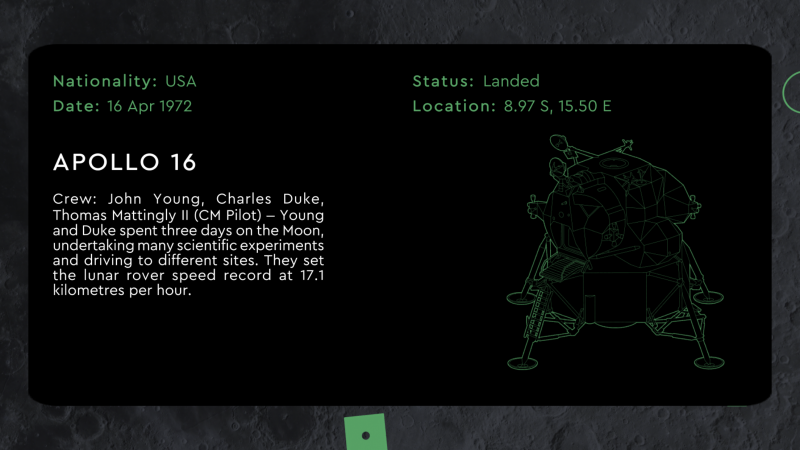
Apollo 16 LM on lunar surface (NASA)
Send them to the moon
With a smartphone and a bit of carboard, museums’ aspirations for immersive experiences can reach astrological heights, writes Kaitlin Fritz.
So often when we think of the term “immersive” in the cultural sector, minds jump to sleek exhibitions with tethered headsets and controllers, or large footprint attractions exploring history or time. What you may not realise is that if you have been on a virtual museum tour during lockdown or scanned an artwork in augmented reality (AR), then you have had an immersive experience.
Technical capabilities
Immersive has become increasingly popular over the past five years, with exhibitions like Tate’s Modigliani, and Louvre’s Leonardo Da Vinci painting an archetype in virtual reality (VR). Some have pushed it further: TeamLab’s Story of a Forest goes beyond the headset, creating a surreal ‘extended reality’ (XR) digital installation. The notion of immersive must, by definition, expand to encapsulate the potential of all AR, VR, and XR technologies within the sector that go beyond the major VR installations we have previously seen. Museum leaders should be on the forefront of this knowledge and its applications within the arts. Immersive, like many fields of technology, has a depth and breadth wider than Oculus or Vive headsets. Its potential for cultural learning is still largely untapped. Even in the age of the pandemic, institutions are still navigating their way through the immersive landscape to define what this term means to their organisation and how best to apply it to their digital strategy.
Often thought of for its technical capacities, immersive is better approached as a tool to facilitate layers of audience engagement and storytelling. It allows audience members young and old to be entranced with the minutiae of an artwork, go on a prehistoric adventure flying alongside a pterodactyl – or even have a one to one conversation with Sir David Attenborough. It brings objects to life with a newfound sense of wonder and weaves together layers of additional audio and visual information (or even smell!) that no other tech can.
So when should museums use this medium? In an ideal world, immersive should be a holistic experience that complements the museum’s collections rather than competing with or temporarily replacing them. VR museum tours have been on a rise since the pandemic, but would it do justice to museums’ collections to make this into the new normal? The physical experience of forging a connection with the history of amazing people and objects inside the museum cannot be replicated in the exact same manner. The museum will always be the voice of authority and authenticity, but with emerging mediums the cultural sector can reach audiences beyond an institution’s walls.
Astrological phenomenon
Research by Maria Shehade and Theopisti Stylianou-Lambert echoes the sentiment that VR is best used to enhance the experience in a way a user could not get in “real life”. One of their museum interviewees is quoted as saying:
“I think where it gets challenging is when you try to use VR to replace the gallery experience or to provide a gallery experience in a virtual environment. That’s not what it is good for. It’s good for offering a different kind of experience. So use VR to create experiences that people can’t get anywhere else… don’t try and make a virtual museum or gallery, make something else, a studio, a scene, a location, or send them to the moon.”
With London-based culture education technology company Musemio, Royal Museums Greenwich did just that – explore the moon. Using mobile VR technology, which includes an app and a cardboard VR headset, Royal Museums Greenwich created and beta-launched Moon Viewer with Musemio. Inspired by the museum’s celebration of the 50th anniversary of the Apollo 11 Mission, Royal Museums Greenwich’s Digital Programmes Producer Hans Biorn-Lian wanted users to be able to step inside the moon and look outwards on its craters. They were able to explore whether they were at home or at the museum, opening families’ eyes to an astronomical phenomenon with minimal equipment.

Screenshot taken from the Moon Viewer app
As an immersive project, Moon Viewer engaged various arms of Royal Museums Greenwich. With her background in research as an astrophysicist, Dr. Emily Drabek-Mauder, Senior Manager of Public Astronomy at the Royal Observatory, gave insight on how to achieve an accurate representation of the lunar surface. She spoke about the Moon Viewer in the Culture Reimagined 2020 Summit: “The virtual reality technology allows people to interact and experience the moon in a way that they have not had a chance to do,” she said. “What is nice is that the user can decide what they want to learn about… not only can individuals download the app and do their own learning, but also it can be used in museum-like workshops.”
Strength in simplicity
Though designed with a simple headset, Moon Viewer has the unique capacity to be encountered both within VR and in 2D while remaining as immersive and interactive as possible. This also allows greater accessibility across devices and enables the user to decide how they want to experience the lunar surface. Biorn-Lian said that “Moon Viewer's strength lies in its simplicity, both in concept and design”. You don't need expensive hardware to have an immersive experience of the moon and its crewed and robotic missions – just your phone and a cardboard headset.
Using cardboard to experience another dimension may sound like a paradox, but this immersive technology is opening a realm of opportunity without a hefty price tag. The benefit of using this type of VR is allowing families and children under 13 to become involved in the learning journey. Musemio uses the technology in our pockets, which provides greater accessibility and audience reach than a standalone headset.
This is only one cast study. What would your museum like to bring to life in new and engaging ways? How could you portray objects in a new light to spark imagination and curiosity in the audiences of the future? With the ever-expanding and adaptable world of immersive, cultural leaders can be on the forefront of audience outreach and engagement for years to come.
Kaitlin Fritz is the Co-Founder and COO of Musemio.
![]() musemio.com
musemio.com
![]() Musemio
Musemio
![]() @MusemioUK
@MusemioUK
If you would like to expand your understanding of immersive and workshop your museum's digital strategy, please register for Musemio’s free digital conference, Culture Reimagined: Digital Champions Summit on 25 March. And, if you would like to learn more about this collaboration or Musemio’s services, please email [email protected].
This article, sponsored and contributed by Musemio.
Join the Discussion
You must be logged in to post a comment.